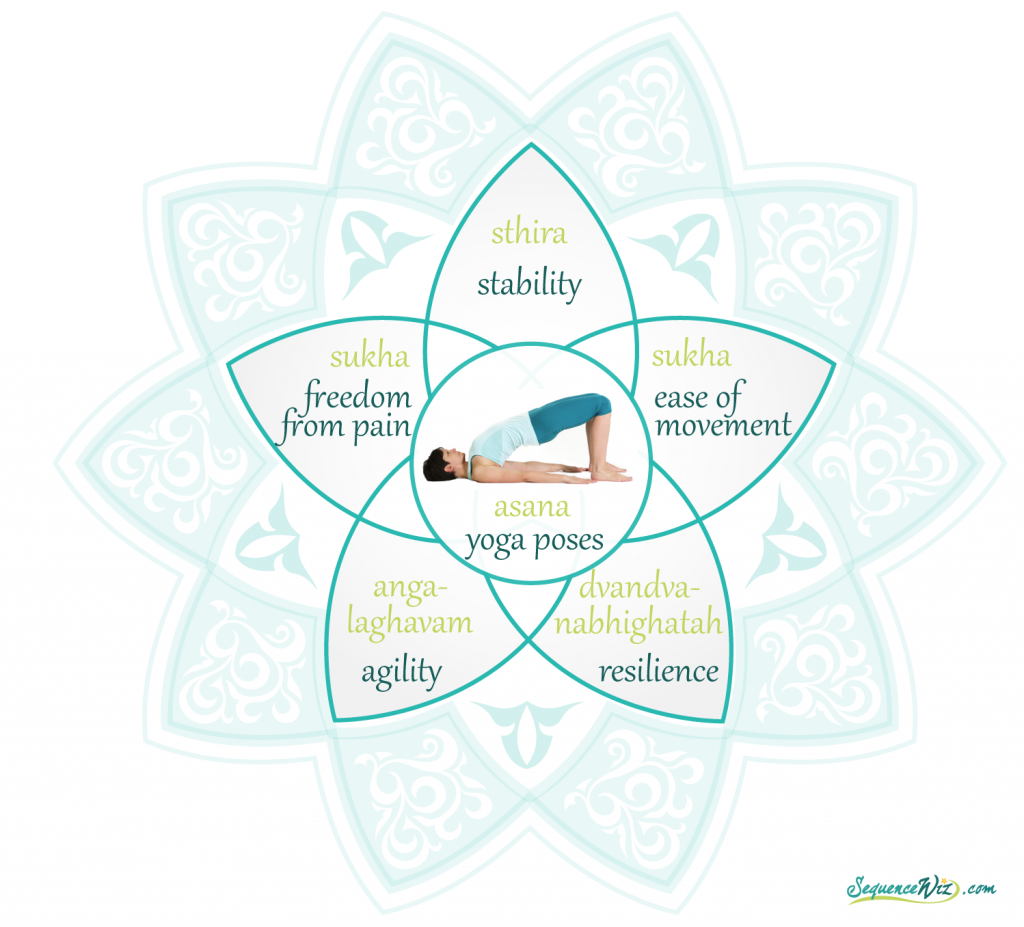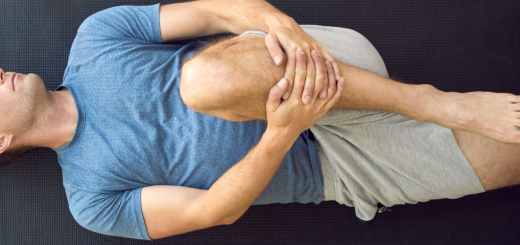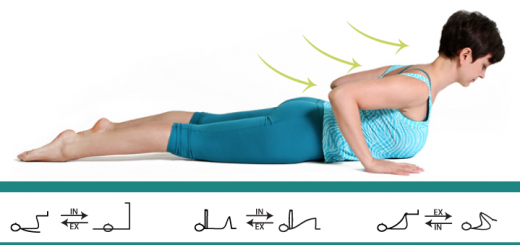Traditional goals of asana practice
18Nowadays we tend to define our health and fitness mostly through numbers (body mass index, target heart rate and so on) and performance (ability to touch the toes, run a marathon or do a certain number of squats). It is easy to bring the same mindset to a yoga class and celebrate being able to hold Extended Side Angle for two minutes or master a Handstand. Our minds feel more comfortable with concrete goals. Setting goals like that is perfectly fine as long as we don’t loose sight of the big picture.
Nowhere in the traditional yogic text will you find any talk about muscles, fitness or physical accomplishments. Instead yogis concerned themselves with nourishing the Annamaya (physical body) to provide a suitable container for our energy and support our mental development.
For the yogis health and fitness were defined in the following terms:
1. Sthira – stable structure that can remain upright and balanced within gravitational pull.
2. Sukha (which literally means “good space, free of suffering”) can be defined both as ease of movement to enable us to do whatever we want to do, and freedom from physical pain that can be distracting for our energetic and mental pursuits.
3. Angalaghavam – feeling of lightness in the body; it could also be described as agility. It allows us to move through the day with fluidity, grace and confidence.
4. Dvandvanabhighatah – ability to withstand change. Every day brings a new challenge and we need to make sure that it doesn’t knock us off our feet. We can call this resilience.
To summarize, our yoga practice is supposed to make us structurally stable, enable us to move with grace and ease, free us from physical suffering and enable us to withstand changing circumstances.
Asana is the most useful tool to work with our physical bodies. Practicing asana makes us stronger and more flexible, helps us relieve physical discomfort, cultivates agility and resilience.
Here is the trick though. Have you ever noticed that students who choose strong, fast and challenging yoga practices are usually the proverbial type-A personalities, who are already driven and demanding of themselves and others? And students who have trouble with self-discipline and self-motivation tend to gravitate toward slower pace and more restorative practices? This is a manifestation of a fundamental Ayurvedic principle that states that “Like increases the like”. It means that we are naturally attracted to the activities and practices that match our established inner qualities. If I am driven and demanding, I will seek out activities that make me even more driven and demanding. If I am slow-moving and not very ambitious, I will engage in activities that encourage those qualities.
This is NOT how we should approach our yoga practice, say the yoga sutras. According to sutra 2.47, one of the most important aspects of an asana practice is prayatna shaithilya, which means “appropriate effort”. Appropriate effort is the kind that BALANCES OUT our inner qualities, not amplifies them. So if we lead a very active demanding life, our yoga practice should be more soothing for the system; if we lead a mellow, low activity life, our yoga practice should encourage a bit more discipline, strength and persistent effort. That is why it is important for us to recognize our inner drives and then find or create a yoga practice that balances out our personality traits and the rest of our lives. To quote my teacher Gary Kraftsow: “Traditionally, the practice of asana was always considered as an integral part of a holistic practice, never as an isolated fitness system.” Whatever we do with our physical bodies has no value in and of itself unless we apply it to living a more balanced, mindful and conscious life.
[jetpack_subscription_form]




















I so much appreciate all your blogs, Olga. This recent one succinctly summarizes what I have been trying to teach for many years now, but I find it hard to sometimes explain the non-physical benefits of yoga. You have done it perfectly here. Thank you.
Thank you Diane! Glad I could help 🙂
Thank you for this clear and interesting piece, Olga. Do traditional texts ever speak of not only being able to ‘withstand changing circumstances’ but also to ‘flourish/thrive’ in the process of life unfolding?
Absolutely! Over the next year I will be quoting extensively from the yoga sutras to show how profound and applicable to daily life those teachings are. I am happy to see that you are interested!
Olga, thank-you so much for this eloquently, succinct post 😀
Your reference to the quote from ayurveda is very pertinent, I have heard A G Mohan also mention it; it’s a challenge to convince people (including ourselves!) that what we want from a practice and what we need may be a little at odds… so, Patanjali in his great wisdom, stressed the importance of tapa; “putting up with the inner discomfort of doing what we need, not what we want” Hmmmm it’s a work in progress! Thanks Olga, keep doing what you do you’re an inspiration <3
Excellent point Louise, thank you!
Lovely! And very welcome with the expansion of yoga social media with its beautiful, oiled bodies performing impressive sequences that seem more like gymnastics! Thank you for the spiritual grounding. Looking forward to the following ones!
🙂 Your description of “beautiful, oiled bodies” reminds me of fitness competitions from the 90s 🙂 Definitely NOT what I am looking for in my yoga practice.
Thank you Olga. I am certain I practiced for years in the manner which you described: emphasizing my natural tendencies towards high levels of activity, and avoiding slower more restorative and grounding work. (I am very vattic). I think part of the appeal also in going with what we like is the satisfaction the ego gets from performing well. As a teacher now I try to remind myself and my students of the healing aspect of yoga. We can play hard in other activities and then come to the mat for the healing and balancing of yoga. I also like the comment that Louise shared about the importance of tapa. I am so very grateful for your posts; the wisdom you share so generously.
Hi Rebecca! I completely agree with you about “the satisfaction that ego gets from performing well” – this is a fantastic observation! I see it all the time in my 5 year old – he would much rather do things that he is already good at 🙂 Hopefully we get a bit more self-aware as we continue to practice 🙂
Thank you for another excellent and insightful article.
Beautifully articulated Olga. The longer I practice yoga and its paths, the more I tune into the physical AND subtle needs of my body. Western yoga is
somewhat of a circus. I was a part of it for over 15 years; and finally my body said “enough.” Shoulder and hand surgery ensued due to overuse, over and over again. (When I ripped my thenar muscle in class, my pitta self finished the practice and THEN went to the doctor – no good).
The last 10 years I’ve come into a gentle agreement with my body to be more patient and to feel more. Thanks for always writing such accessible and thoughtful articles Olga. You are a gem.
This is why Yoga cannot be considered a complete physical fitness regimin. It really is a religion.
Hi Ed! Yoga was never meant to be a fitness regimen, but it isn’t a religion either. It is much closer to psychology since it concerns itself with how the mind works. It is usually defined as “darshana” from the Sanskrit root “drsh” which means “to see”. So you can define yoga a discipline that helps you see life for what it is, and ourselves for who we are.
Such words of wisdom – as usual – hits the nail on the head. Thank you – again.
An excellent post Olga, THANK YOU ,
VERY timely for me as we have been discussing in class some of the challenges that people have who want to get on with more challenging postures & feel frustrated when they don’t know why from the outset as to what it is there are trying to ACHIEVE OR DO , as you say more Type A People who find it challenging to just BE in the moment ( rather than faster better harder to satisfy one’s ego) slowing down, and allowing through the Practice of ASANA our habitual reactions and preferences to unfold, physically emotionally and by coming back to the mindful breath when we get to in our heads, when we want to speed up or become self hating & critical for not getting IT or doing it right !!
Through the process of a mindful yoga practice & an opportunity to become more self aware, of our inner critic and of others and with this awareness choose to do something different to lead a kinder nurturing, life to self and others. Namaste OLGA 🙂
Thank you, Olga, for putting so clearly and succinctly the path of yoga–aware, non-egoic presence. After practicing and teaching yoga and meditation for nearly 50 years, I’m always amazed at how much more there is to surrender…and smile, Really empowering post. Namaste.
I must have missed this one from this past year. Thank you – what a great theme to start the new year with my classes!
I appreciate all that you do 🙂